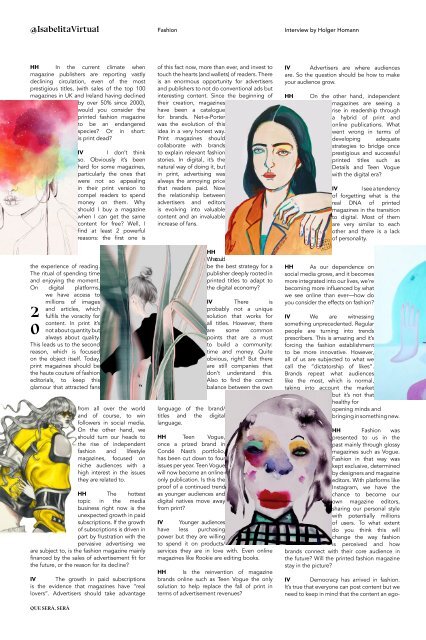Radical Vertical
The magazine is published in collaboration between radicalvertical, Berlin, kulturspace, Los Angeles & LAFFF.
The magazine is published in collaboration between radicalvertical, Berlin, kulturspace, Los Angeles & LAFFF.
Create successful ePaper yourself
Turn your PDF publications into a flip-book with our unique Google optimized e-Paper software.
@IsabelitaVirtual<br />
Fashion<br />
Interview by Holger Homann<br />
HH In the current climate when<br />
magazine publishers are reporting vastly<br />
declining circulation, even of the most<br />
prestigious titles, (with sales of the top 100<br />
magazines in UK and Ireland having declined<br />
by over 50% since 2000),<br />
would you consider the<br />
printed fashion magazine<br />
to be an endangered<br />
species? Or in short:<br />
is print dead?<br />
the experience of reading.<br />
The ritual of spending time<br />
and enjoying the moment.<br />
On digital platforms,<br />
we have access to<br />
millions of images<br />
and articles, which<br />
2<br />
0<br />
fulfils the voracity for<br />
content. In print it’s<br />
not about quantity but<br />
always about quality.<br />
This leads us to the second<br />
reason, which is focused<br />
on the object itself. Today,<br />
print magazines should be<br />
the haute couture of fashion<br />
editorials, to keep this<br />
glamour that attracted fans<br />
IV I don’t think<br />
so. Obviously it’s been<br />
hard for some magazines,<br />
particularly the ones that<br />
were not so appealing<br />
in their print version to<br />
compel readers to spend<br />
money on them. Why<br />
should I buy a magazine<br />
when I can get the same<br />
content for free? Well, I<br />
find at least 2 powerful<br />
reasons: the first one is<br />
from all over the world<br />
and of course, to win<br />
followers in social media.<br />
On the other hand, we<br />
should turn our heads to<br />
the rise of independent<br />
fashion and lifestyle<br />
magazines, focused on<br />
niche audiences with a<br />
high interest in the issues<br />
they are related to.<br />
HH The hottest<br />
topic in the media<br />
business right now is the<br />
unexpected growth in paid<br />
subscriptions. If the growth<br />
of subscriptions is driven in<br />
part by frustration with the<br />
pervasive advertising we<br />
are subject to, is the fashion magazine mainly<br />
financed by the sales of advertisement fit for<br />
the future, or the reason for its decline?<br />
IV The growth in paid subscriptions<br />
is the evidence that magazines have “real<br />
lovers”. Advertisers should take advantage<br />
of this fact now, more than ever, and invest to<br />
touch the hearts (and wallets) of readers. There<br />
is an enormous opportunity for advertisers<br />
and publishers to not do conventional ads but<br />
interesting content. Since the beginning of<br />
their creation, magazines<br />
have been a catalogue<br />
for brands. Net-a-Porter<br />
was the evolution of this<br />
idea in a very honest way.<br />
Print magazines should<br />
collaborate with brands<br />
to explain relevant fashion<br />
stories. In digital, it’s the<br />
natural way of doing it, but<br />
in print, advertising was<br />
always the annoying price<br />
that readers paid. Now<br />
the relationship between<br />
advertisers and editors<br />
is evolving into valuable<br />
content and an invaluable<br />
increase of fans.<br />
language of the brand/<br />
titles and the digital<br />
language.<br />
HH Teen Vogue,<br />
once a prized brand in<br />
Condé Nast’s portfolio,<br />
has been cut down to four<br />
issues per year. Teen Vogue<br />
will now become an onlineonly<br />
publication. Is this the<br />
proof of a continued trend<br />
as younger audiences and<br />
digital natives move away<br />
from print?<br />
HH<br />
What could<br />
be the best strategy for a<br />
publisher deeply rooted in<br />
printed titles to adapt to<br />
the digital economy?<br />
IV There is<br />
probably not a unique<br />
solution that works for<br />
all titles. However, there<br />
are some common<br />
points that are a must<br />
to build a community:<br />
time and money. Quite<br />
obvious, right? But there<br />
are still companies that<br />
don’t understand this.<br />
Also to find the correct<br />
balance between the own<br />
IV Younger audiences<br />
have less purchasing<br />
power but they are willing<br />
to spend it on products/<br />
services they are in love with. Even online<br />
magazines like Rookie are editing books.<br />
HH Is the reinvention of magazine<br />
brands online such as Teen Vogue the only<br />
solution to help replace the fall of print in<br />
terms of advertisement revenues?<br />
IV Advertisers are where audiences<br />
are. So the question should be how to make<br />
your audience grow.<br />
HH<br />
On the other hand, independent<br />
magazines are seeing a<br />
rise in readership through<br />
a hybrid of print and<br />
online publications. What<br />
went wrong in terms of<br />
developing adequate<br />
strategies to bridge once<br />
prestigious and successful<br />
printed titles such as<br />
Details and Teen Vogue<br />
with the digital era?<br />
IV I see a tendency<br />
of forgetting what is the<br />
real DNA of printed<br />
magazines in the transition<br />
to digital. Most of them<br />
are very similar to each<br />
other and there is a lack<br />
of personality.<br />
HH As our dependence on<br />
social media grows, and it becomes<br />
more integrated into our lives, we’re<br />
becoming more influenced by what<br />
we see online than ever—how do<br />
you consider the effects on fashion?<br />
IV We are witnessing<br />
something unprecedented. Regular<br />
people are turning into trends<br />
prescribers. This is amazing and it’s<br />
forcing the fashion establishment<br />
to be more innovative. However,<br />
all of us are subjected to what we<br />
call the “dictatorship of likes”.<br />
Brands repeat what audiences<br />
like the most, which is normal,<br />
taking into account the market<br />
but it’s not that<br />
healthy for<br />
opening minds and<br />
bringing in something new.<br />
HH Fashion was<br />
presented to us in the<br />
past mainly through glossy<br />
magazines such as Vogue.<br />
Fashion in that way was<br />
kept exclusive, determined<br />
by designers and magazine<br />
editors. With platforms like<br />
Instagram, we have the<br />
chance to become our<br />
own magazine editors,<br />
sharing our personal style<br />
with potentially millions<br />
of users. To what extent<br />
do you think this will<br />
change the way fashion<br />
is perceived and how<br />
brands connect with their core audience in<br />
the future? Will the printed fashion magazine<br />
stay in the picture?<br />
IV Democracy has arrived in fashion.<br />
It’s true that everyone can post content but we<br />
need to keep in mind that the content an ego-<br />
QUE SERÁ, SERÁ





